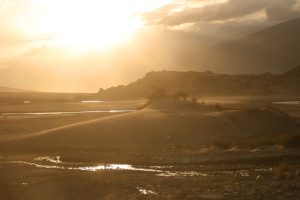Facing acute drought conditions, the Taliban government is undertaking an ambitious program to upgrade its water infrastructure. However, the program has elevated tensions with the countries surrounding Afghanistan. Kabul lacks the technical ability to harness its water resources fully, but it can make life more miserable for its water-challenged neighbors.
Two years of drought have created widespread food scarcity in Afghanistan. The April 17 World Food Program Situation Report states Afghanistan is at the highest risk of famine in a quarter century. Many reservoirs around the country are running low. For example, the Band-e-Qargha is at about a third of its typical level, disrupting local tourist sites and limiting the water supply to Kabul. Many farmers are fearful for their crops this season. Agriculture accounts for half of Afghanistan’s gross domestic product, with 85 percent of the population working in the sector.
The Afghan Ministry of Energy and Water, currently led by the Taliban’s former military commander, governor, and agriculture minister Abdul Latif Mansoor, is not idle. On April 3, the ministry announced an ambitious program of more than 400 projects for the upcoming Afghan calendar year. The slate includes improving the Kamal Khan Dam in Nimroz Province and numerous smaller dams to improve irrigation and limit flooding.
The crown jewel of the Taliban’s effort is the massive Qosh Tepa Canal. The 285-kilometer canal project, which employs more than 5,000 people and 3,000 pieces of construction equipment, will irrigate an estimated 550,000 hectares of land if completed as designed.
However, the Taliban’s ability to unilaterally complete the announced list of projects is an open question. Construction timelines for most projects are difficult to find, and design details are scarce. Many Afghan experts have left the country after the Taliban assumed control, but some capability remains in Afghanistan.
Afghan engineers started the Tori Dam in September 2022, a $1.15 million project to irrigate 600 hectares of land and generate 1000 kilowatts of electricity. Like Qosh Tepa, Afghan firms are building the dam. However, the Afghans are cutting corners, raising concerns about efficiency and safety. Qosh Tepa is unlined, which means the canal could lose 60 percent of its water to seepage and face water quality issues.
A very small number of international partners are willing to engage with the Taliban, including cooperation on water infrastructure projects. The United Nations continues some cooperation, including the small Lodan Dam along the Kunar River, which is 80 percent complete. Turkey helped complete a $160 million upgrade to Kajaki Dam in Helmand Province in July 2022 and met with Afghan officials in April to negotiate further work at the facility. In January, Beijing’s China Road and Bridge Corporation expressed interest in building water storage dams in Afghanistan.
However, sanctions on Mansoor and other Taliban senior leaders complicate efforts to do business with the regime. Afghanistan’s limited transportation connections and poor infrastructure further challenge even determined partners. Additionally, the Islamic State’s local branch has brought the Taliban’s ability to provide security into question with separate attacks on a Pakistani envoy and Chinese diplomats and traders in Kabul.
Afghanistan has little hope of cooperating with its neighbors, as many of its projects come at their expense. As The Diplomat noted in April, Turkmenistan and Uzbekistan are aghast at Qosh Tepa’s progress as it deprives them of much-needed water. Both countries are facing extensive water shortages, and the Amu Darya River cannot afford to lose the 10 billion cubic meters the Qosh Tepa will divert. The Central Asian states lack a treaty framework to resolve these issues.
Similarly, Pakistan lacks a regulatory framework for the Kabul River, which flows from Afghanistan into the Indus. The neighbors share eight rivers across the Durand Line, and upstream work has historically caused trepidation in Islamabad.
Perhaps Kabul’s biggest problem is with Tehran, which claims the Kamal Khan Dam is withholding Iran’s share of the Helmand River, as dictated by the 1979 bilateral water treaty.
The Taliban have little choice but to keep building. Afghanistan’s economy, and perhaps its internal stability, depends on the efficacy of the water management project. While its neighbors are rightfully concerned about the impact of Afghanistan’s large projects on their water access, even the smaller dams will impact international water flows. The vast size of Afghanistan’s watersheds means that even small dams without flow controls, like the Tori and Lodan, will limit flows out of the country.
Despite this, Afghanistan’s neighbors are not without levers. Iran, Turkmenistan, and Uzbekistan all provide critical electricity to Afghanistan. Iran has also used the large number of Afghan refugees in its territory as leverage against Kabul. Conversation and diplomacy continue to keep tensions in check. However, water shortages will test the patience of Afghanistan’s neighbors. There is simply not enough water to go around, and the Taliban will use their position upriver to protect their interests.
































